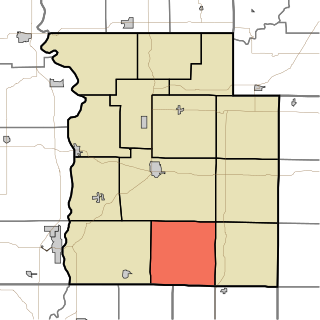
Parke County lies in the western part of the U.S. state of Indiana along the Wabash River. The county was formed in 1821 out of a portion of Vigo County. According to the 2010 census, the population was 17,339, an increase of 0.6% from 17,241 in 2000. The county seat is Rockville.

Rockville is a town in Adams Township, Parke County, in the U.S. state of Indiana. The population was 2,607 at the 2010 census. The town is the county seat of Parke County. It is known as "The Covered Bridge Capital of the World".

Adams Township is one of thirteen townships in Parke County, Indiana, United States. As of the 2010 census, its population was 5,825 and it contained 2,062 housing units.

The Nevins Covered Bridge is a single span Burr Arch Truss covered bridge that crosses Little Raccoon Creek on County Road 130 East, just southeast of Catlin, Indiana. It was built in 1920 by Joseph A. Britton and Son. Prior to the reconstruction of the Bridgeton Bridge in 2006, the Nevins Bridge was the newest covered bridge in Parke County.

The Crooks Covered Bridge is a single span Burr Arch Truss structure that crosses Little Raccoon Creek built in 1855-1856 by Henry Wolf just southeast of Rockville, Indiana.

The Beeson Covered Bridge originally crossed Roaring Creek, one mile (1.6 km) northwest of Marshall, Indiana, on County Road 216, in Washington Township, Parke County. The bridge was moved to its current location in Billie Creek Village in December 1979.

The Catlin Covered Bridge is a single span Burr Arch truss covered bridge structure that was built by Clark McDaniel in 1907.

The Sanitorium Covered Bridge is a bridged located east of Rockville, Indiana. The single-span Burr Arch covered bridge structure was built by Joseph A. Britton in 1913.

The Wilkins Mill Covered Bridge is north of Rockville, Indiana. The single span Burr Arch Truss covered bridge structure was built by William Hendricks in 1906. The bridge is 120 feet (37 m) long, 16 feet (4.9 m) wide, and 13 feet (4.0 m) high.

Florida Township is one of thirteen townships in Parke County, Indiana, United States. As of the 2010 census, its population was 2,378 and it contained 1,073 housing units.

Raccoon Township is one of thirteen townships in Parke County, Indiana, United States. As of the 2010 census, its population was 659 and it contained 345 housing units.

Union Township is one of thirteen townships in Parke County, Indiana, United States. As of the 2010 census, its population was 1,562 and it contained 1,451 housing units.
Joseph Albert Britton (1839–1929), most commonly known as J.A. Britton, was a builder of bridges in Indiana. He created many works that survive and are listed on the U.S. National Register of Historic Places.
Billie Creek Village is (was) a 70-acre open-air living history museum and park, filled with 38 historical buildings and structures, and hundred of antiques and artifacts. It is located at 39.7614298°N 87.2019582°W near Rockville, Adams Township, Parke County, Indiana in the area known as the "Covered Bridge Capital of the World" for the county's 31 covered bridges. It was formed in 1964/1965 by residents of Parke County, and opened its doors in 1969. The group Parke County, Inc. helped to form it, and a separate group, Billie Creek Village, Inc, was formed for operating it. The village took its name from nearby Williams Creek.
The Adams Covered Bridge was east of Rockville, Indiana. The single-span Burr Arch covered bridge structure was built by the Adams Construction in 1907 and destroyed by flood in 1969.
The Dooley Station Covered Bridge was east of Dooley Station, Indiana. The Burr arch truss style single span covered bridge crossed Little Raccoon Creek and was built by W.C. Carty in 1917 and destroyed by arson in 1960.
The Hollandsburg Covered Bridge was southeast of Hollandsburg, Indiana. The single-span Burr Arch covered bridge structure was built by J. J. Daniels in 1872 and torn down in 1930 during the expansion of U.S. Route 36 (US 36).
The Howard Covered Bridge was east of Rockville, Indiana. The single-span Burr Arch covered bridge structure was built by J. A. Britton in 1913 and torn down in 1931 or 1932 during the expansion of U.S. Route 36 (US 36).
The Plank Road Covered Bridge was east of Rockville, Indiana. The single-span Burr Arch covered bridge structure was built by Henry Wolf in either 1854 or 1859 and destroyed in the Great Flood of 1913.
The Weisner Covered Bridge was southwest of Catlin, Indiana. The single-span King Post covered bridge structure was built by Joseph A. Britton in 1908 and destroyed by flood in 1957.










